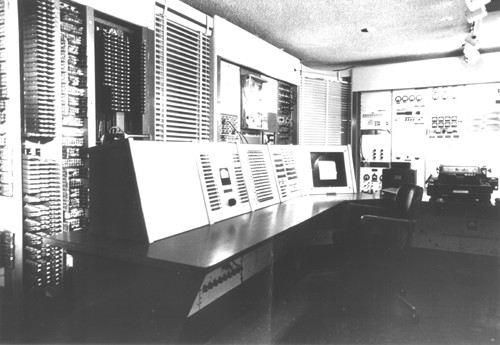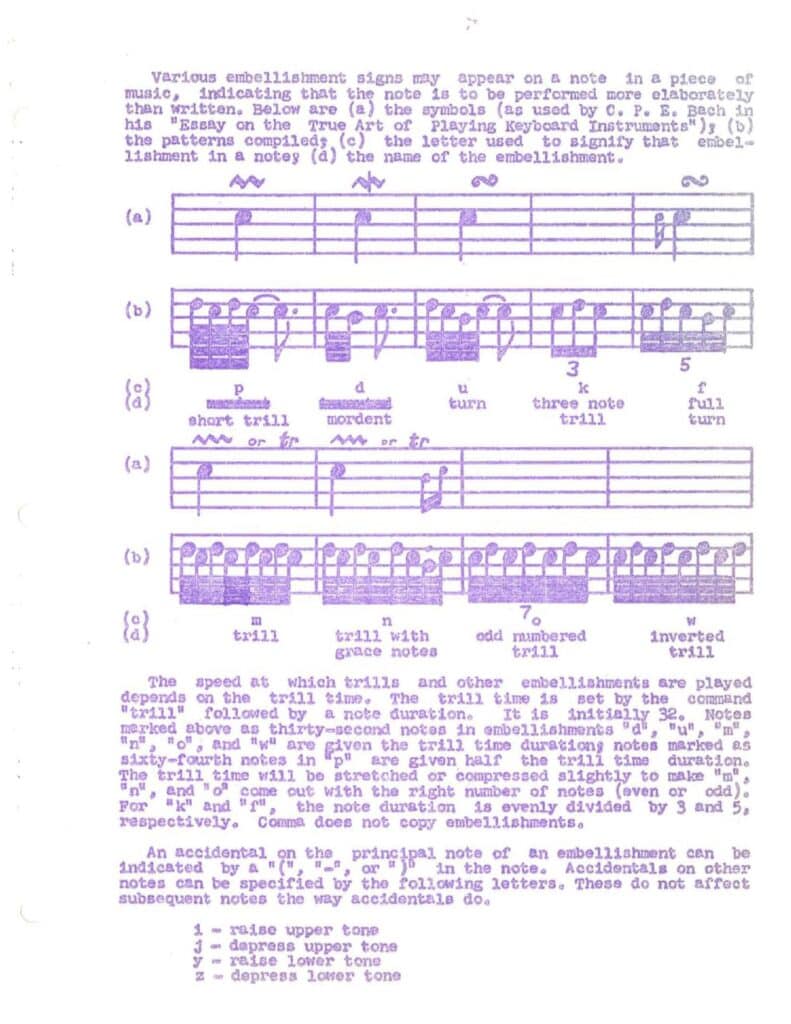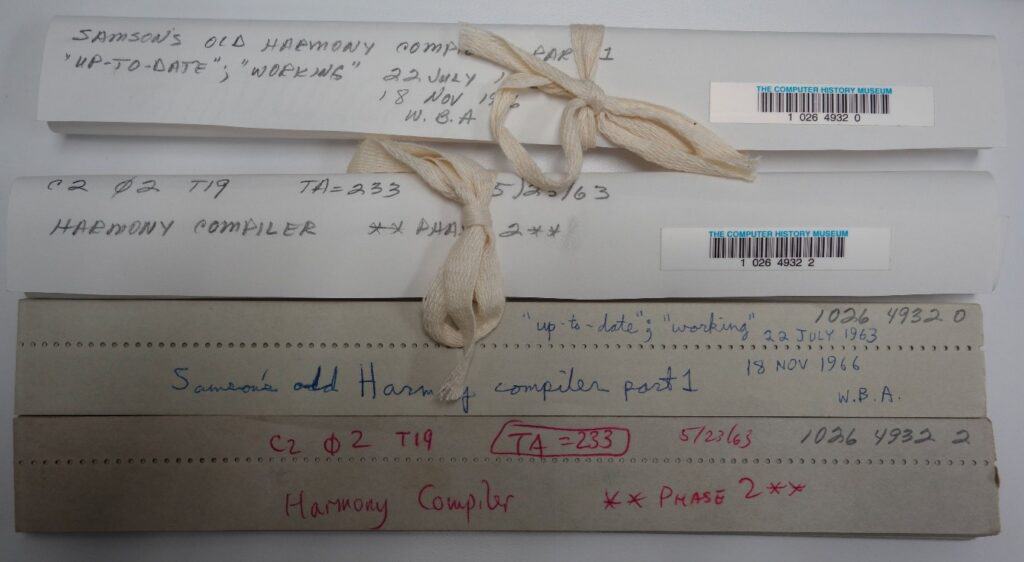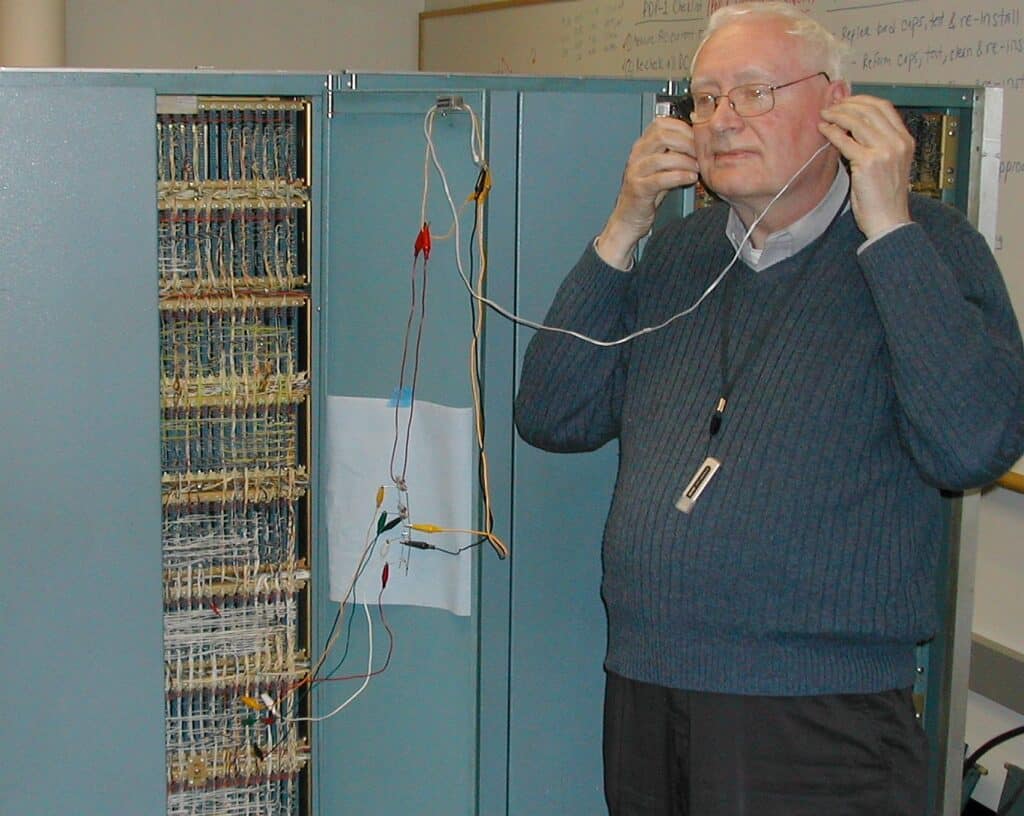
In 1961, Peter Samson, a student at MIT, programmed the new PDP-1 minicomputer to play polyphonic music. This experiment led to the Harmony Compiler, one of the earliest pieces of music-making software to be distributed to users. It also inspired Peter’s later pioneering work in real-time digital sound synthesis.
Nowadays, Peter is working as a docent at CHM. I interviewed him in 2020 in the PDP-1 lab, where he demoed the music software and explained how he developed it.
Peter Samson loads a paper tape of polyphonic music on the PDP-1.
Peter’s system was novel in 1961 because it was both real-time and polyphonic: real-time meaning that the computer could play music "live," polyphonic meaning it could play more than one note at a time.
As early as 1951, engineers in Australia programmed the CSIRAC computer to play music in real-time, but only monophonically (one note at a time). At Bell Labs, Max Mathews achieved polyphony with his MUSIC software in 1958, but this worked in "batch mode," not real-time: running a "job" on punched cards produced a digital waveform on tape, which could be played back later via a custom-built digital-to-analog converter.
Closer to home, Ercolino Ferretti was developing experimental sound synthesis programs for MIT’s IBM 7094 mainframe, but these too were non-real-time. "Real-time was my thing from the start," Peter told me. "Hands-on interaction versus, you know, submit your job."
Peter first attempted real-time synthesis in 1960 when he programmed MIT’s experimental TX-0 computer to play monophonic melodies. He did this by writing a program that sent precisely timed pulses to the machine’s built-in speaker: 262 pulses per second for "middle C," 294 pulses per second for "D," and so on. Timing the bits to coincide with the machine’s instruction cycle required clever programming, Peter recalled—but an even greater challenge arose when he considered rewriting the program to play several notes simultaneously.
"Where are we going to store multiple bits?" he wondered.
His solution was to use outboard flip-flops. A flip-flop is a digital circuit whose output can be switched "on" (positive voltage) or "off" (no voltage) by an electrical control signal. With such a circuit, it is possible to generate an electrical waveform roughly the shape of a square wave by switching the circuit on and off at regular intervals.

A photograph of the TX-0, ca. 1956 in CHM's collection, 102622467. Courtesy of Gwen Bell
The TX-0 had plug-in flip-flop units controlled from the machine’s processor. Peter determined that by using three of these, it would be possible to make the machine play three different musical notes simultaneously. Going a step further, he hypothesized that three-part polyphonic music might be attainable by programming the machine to play a sequence of three-note combinations one after the other. To test that hypothesis, he set about writing a new three-voice music player program.
Achieving three-part polyphony required an appropriate choice of music. Peter chose the "Presto" movement of J.S. Bach’s Organ Concerto in G Major, partly because he loved the music, and because the sound of an organ could be reasonably convincingly emulated using the means at his disposal.
"If you’re generous, it sounds like a pipe organ," he reflected.
Programming TX-0 to play "contrapuntal"music—that is, music with multiple melodic lines—required Peter to conceptualize the music in an unconventional way. Musicians tend to think of three-part counterpoint "horizontally," as three simultaneous intertwining melodies. Instead, Peter thought of the music "vertically." He observed that in three-part polyphonic music, at any given instant, there may be up to three notes sounding simultaneously. His chosen piece, for example, begins with a high "G" in the right hand, "B" in the left hand, and low "G" in the pedal part, a situation that persists for the duration of a sixteenth-note. Then, the right hand changes to a high "D" and the left hand to a low "D," while the pedal part holds the low "G" for a further sixteenth-note, and so on. In other words, Peter thought of the music as a sequence of three-note "instants," each consisting of pitch 1, pitch 2, pitch 3, and duration N. An "instant," he explained to me, is an arbitrary duration in which the pitches of all three voices remain constant.
To realize this concept, Peter wrote a music player program that read frequency and duration data, in three-note instants, from punched paper tape into TX-0’s magnetic core memory. The program switched the three flip-flops on and off simultaneously at the specified frequencies, holding each three-frequency combination for the specified duration before moving on to the next one. The flip-flops were connected to an electronic filter, amplifier, and loudspeaker, which removed some noise components of the signals and rendered them readily audible as musical notes.
Below is an audio clip of the third movement, "Presto," from J.S. Bach's Organ Concerto in G Major on PDP-1.
The three-part music player program worked well, but there was a problem: entering the data was very time consuming. Rendering a complete piece of music required Peter to manually divide the music up into three-note instants, calculate the frequency of each note and the number of loop iterations required to produce the correct duration for each instant, then painstakingly enter the data on paper tape. Having completed that process for the Bach organ concerto, Peter recalled his frustration.
"I’m not doing that again!" he told me. "I’m going to write a compiler."
Peter’s work on the Harmony Compiler coincided with the arrival at MIT of a new PDP-1 minicomputer, a commercial machine based on the design of the experimental TX-0. Peter wrote the compiler to be cross-compatible with both machines. The compiler enabled him to follow a musical score and enter the note data in a simple symbolic shorthand: one number represented the note’s pitch-position on the stave; another, its duration as a quarter note, eighth note, sixteenth note, and so on. The compiler converted these numbers into frequency and loop-iteration values, meaning Peter no longer had to do those calculations manually.
Peter also devised a system of character symbols for musical articulation, and even Baroque ornamentation.

A page from the Harmony Compiler manual. A "staccato" (shortened) note could be specified by appending the letter "s" to a pitch value.

Baroque ornamentation. Trills, mordents, and turns each had character symbols.
Each contrapuntal part could be entered horizontally: the compiler took care of merging the parts and generating the vertical instants that Peter had previously had to figure out on paper. The compiler accepted as its input a punched paper tape containing pitch, duration, and articulation data in this more user-friendly format, and produced as its output a punched paper tape containing the less human-friendly data expected by the music player program.
While the Harmony Compiler was cross-platform, the music player program had to be re-written using the PDP-1’s instruction set. Peter took this opportunity to augment the program’s capabilities to four polyphonic voices, as well as adding routines for rendering the opcodes just mentioned.
Here is an audio clip of J.S. Bach's Two Part Invention No. 1 on PDP-1.
In 1962, the Harmony Compiler and music player became part of the stock software bundle shipped with new PDP-1 machines. This places Peter’s programs amongst the earliest programmable music software packages to be distributed to users.
"DEC paid me $200 to write a version that will run on PDP-1 without the outboard flip-flops," Peter explained.
Peter stopped working with the PDP-1 in 1963. He wrote a six-voice program for the PDP-6 some months later, then left MIT in 1970, but he remained at the forefront of developments in digital synthesis.
In the 1970s, Peter developed the Systems Concepts Digital Synthesizer, one of the first dedicated real-time digital synthesizers. A radically different design based on hardware rather than software, the Samson Box, as it became known, was motivated by the desire to facilitate, in real-time, the superior synthesis capabilities of non-real-time software systems like Max Mathews’ MUSIC programs. The emphasis on real-time made this an extension into the hardware domain of Peter’s earlier work developing synthesis software for the PDP-1 and PDP-6.
Meanwhile, back at MIT, Peter’s music software was maintained by various programmers until, eventually, the PDP lab closed. That would have been the end of the story, if not for the fact that somewhere along the line, a box of paper tapes, including several pieces of music and various parts of the player and compiler programs, made its way from MIT to the Computer History Museum.
It isn’t clear precisely when that happened, or who made the donation, but by extraordinary coincidence, Peter rediscovered this uncatalogued box of tapes in 2004, when he became involved as a volunteer on CHM’s PDP-1 Restoration Project. Playing music on the restored PDP-1 thus became one of the project’s goals.

Two paper tapes containing parts of the Harmony Compiler.
Peter immediately recognized that the programs had been rewritten for various newer systems over the years and would not be able to run on the old PDP-1 hardware. However, he knew the playing algorithm well, and with the salvaged tapes as an aide memoire—plus a flowchart he’d kept that outlined the process for interpreting musical data—he was able to write the player program again from scratch.
Rewriting the compiler forty years after the fact using ambiguously labelled punched paper tapes and a copy of the user manual as a reference would have been a much more onerous task, but in a turn of good fortune, a listing of it turned up in Peter’s basement.
"My wife was rummaging around in the basement and found a box of MIT memorabilia my mother had saved, bless her, and there at the bottom was a print-out of the compiler, a listing. A mere 67 pages? I’ll type it in again! Which I did. So we have a working compiler as well as a working player."
It is only thanks to this somewhat improbable sequence of contingencies that, in 2020, I was able to receive a demonstration of Peter’s PDP-1 music programs—and hear about this important and often overlooked chapter in the history of digital synthesis.

Peter Samson listens to music during the PDP-1 Restoration Project, March 2005.
Members of the PDP-1 Restoration team discuss the project.
Digital synthesis with computers is commonplace nowadays: anybody with a laptop can try their hand at making music using soft synths running within a digital audio workstation (DAW) package like Logic, Reaper, Ableton, or GarageBand. The range of techniques used to generate sounds digitally has expanded enormously since the early 1960s, of course. Frequency modulation (FM), physical modelling, and granular synthesis algorithms have all been implemented in software, for instance.
Samson’s groundbreaking work with TX-0 and PDP-1 predated all these, however, and his programs can perhaps be regarded as the earliest real-time software synthesizers of all.
Thank you to Peter Samson, Heidi Hackford, Al Kossow, and Dag Spicer. Research for this article was supported by British Academy/Leverhulme grant SRG19\190060.